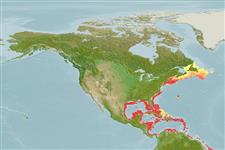Common names from other countries
Environment: milieu / climate zone / depth range / distribution range
Ecologie
; diepteverspreiding 29 - 185 m (Ref. 1821). Tropical
Western Atlantic: USA, Canada and Caribbean.
Length at first maturity / Size / Gewicht / Leeftijd
Maturity: Lm ? range ? - ? cm Max length : 0.4 cm DL mannelijk/geslacht niet bekend; (Ref. 83435)
Maximum depth from Ref. 111279.
Life cycle and mating behavior
Geslachtsrijpheid | Voortplanting | Kuitschieten | Eieren | Fecundity | Larven
Members of the class Scaphopoda are gonochoric. Fertilization occurs in the mantle cavity. Life cycle: Eggs hatch into free-swimming lecithotrophic trochophore larvae, succeeded by shelled veligers.
Steiner, G. and A.R. Kabat. 2004. (Ref. 1821)
Status op de Rode Lijst van het IUCN (Ref. 130435)
Status bij CITES (Ref. 108899)
Not Evaluated
Not Evaluated
Gebruik door de mens
| FishSource |
Tools
Meer informatie
Leeftijd/Grootte
Groei
Lengte-gewicht parameters
Lengte-lengte parameters
Morfologie
Larven
Abundantie
Internet-bronnen
Estimates based on models
Preferred temperature
(Ref.
115969): 0.5 - 26.3, mean 19 (based on 185 cells).
Prijsklasse
Unknown.
